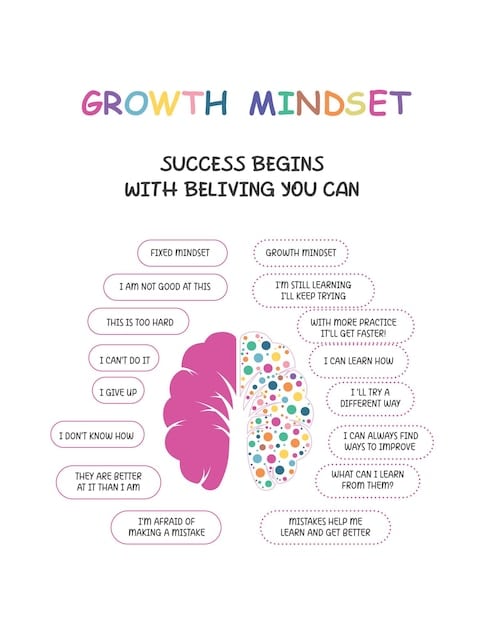The Science of Mindfulness: How It Changes Your Brain in 3 Months

The science of mindfulness reveals that consistent practice, even for just three months, can lead to significant changes in brain structure and function, enhancing emotional regulation, focus, and overall well-being.
Interested in how your mind works? Discover the science of mindfulness: understanding how mindfulness changes your brain in 3 months and unlock the secrets to a more focused and peaceful you.
Understanding the Basics of Mindfulness
Mindfulness has become a popular term in recent years, but what does it really mean? At its core, mindfulness is about paying attention to the present moment without judgment. It’s about observing your thoughts, feelings, and sensations as they arise, without getting carried away by them.
This simple yet profound practice can have a transformative effect on your mental and physical health. But how exactly does mindfulness work, and what makes it so effective?
What is Mindfulness?
Mindfulness is the practice of being fully present and engaged in the current moment. It involves focusing your attention on your experiences, thoughts, and feelings without criticism or evaluation. Instead of dwelling on the past or worrying about the future, you’re simply aware of what is happening right now.
This non-judgmental awareness allows you to gain a greater understanding of yourself and the world around you. It helps you to respond to situations with clarity and compassion, rather than reacting impulsively out of habit or emotion.
The Roots of Mindfulness
While mindfulness has gained popularity in Western cultures in recent years, its roots can be traced back thousands of years to ancient Eastern traditions, particularly Buddhism. The practice of mindfulness meditation is a central component of Buddhist teachings, and it has been used for centuries as a way to cultivate wisdom, compassion, and inner peace.
In recent decades, mindfulness has been secularized and adapted for use in a variety of settings, including healthcare, education, and the workplace. Mindfulness-based interventions, such as Mindfulness-Based Stress Reduction (MBSR) and Mindfulness-Based Cognitive Therapy (MBCT), have been developed to help people manage stress, anxiety, depression, and other mental health challenges.
Here are some key aspects of mindfulness:
- Present moment awareness: Paying attention to what is happening right now, without getting lost in thoughts or worries.
- Non-judgment: Observing your thoughts and feelings without criticism or evaluation.
- Acceptance: Acknowledging your experiences as they are, without trying to change or resist them.
- Compassion: Treating yourself and others with kindness and understanding.
In essence, mindfulness is a way of training your mind to be more present, aware, and accepting. It’s a skill that can be cultivated through regular practice, and it can bring about profound changes in your life.
By understanding the basics of mindfulness, you can begin to explore its potential benefits for your own well-being. The next section will delve into the science behind mindfulness and how it can impact your brain.

The Science Behind Mindfulness and Brain Changes
While mindfulness may seem like a simple practice, the science behind it is quite complex and fascinating. Researchers have been studying the effects of mindfulness on the brain for decades, and they have uncovered compelling evidence that it can lead to significant changes in brain structure and function.
These changes can have a profound impact on your mental and emotional well-being. But how exactly does mindfulness influence the brain, and what are the specific changes that occur?
Neuroplasticity and Mindfulness
One of the key concepts in understanding how mindfulness changes the brain is neuroplasticity. Neuroplasticity refers to the brain’s ability to reorganize itself by forming new neural connections throughout life. This means that the brain is not fixed or static; it is constantly adapting and changing in response to experiences.
Mindfulness practice can promote neuroplasticity by strengthening certain neural pathways and weakening others. For example, studies have shown that regular mindfulness meditation can increase the gray matter density in brain regions associated with attention, emotion regulation, and self-awareness.
Specific Brain Regions Affected by Mindfulness
Several brain regions have been identified as being particularly responsive to mindfulness practice. These include:
- Prefrontal Cortex: Involved in executive functions like planning, decision-making, and working memory. Mindfulness can enhance activity in this region, leading to improved focus and cognitive control.
- Amygdala: Responsible for processing emotions, especially fear and anxiety. Mindfulness can reduce activity in the amygdala, helping to calm the stress response and promote emotional regulation.
- Hippocampus: Plays a crucial role in memory and learning. Mindfulness can increase gray matter density in the hippocampus, improving memory performance and cognitive function.
- Anterior Cingulate Cortex (ACC): Involved in attention, self-awareness, and emotional regulation. Mindfulness can strengthen the connection between the ACC and other brain regions, enhancing emotional processing and self-control.
Research has demonstrated that mindfulness meditation can lead to the following changes in the brain:
- Increased gray matter density in the hippocampus and prefrontal cortex.
- Reduced gray matter density in the amygdala.
- Strengthened connections between brain regions involved in attention, emotion regulation, and self-awareness.
- Improved cognitive function, including attention, memory, and executive functions.
- Enhanced emotional regulation and reduced reactivity to stress.
These changes demonstrate that mindfulness is not just a mental exercise; it is a practice that can physically reshape your brain. The next section will explore what to expect during the initial three months of mindfulness practice.

What Happens to Your Brain in 3 Months of Mindfulness?
The question many people ask is how long it takes to see tangible changes from mindfulness practice. Research suggests that significant brain changes can occur in as little as three months of regular mindfulness practice.
While individual experiences may vary, there are some common patterns and effects that have been observed in studies. Let’s delve into what you might expect during this initial period.
Month 1: Initial Awareness and Adjustment
In the first month, you may primarily notice changes in your awareness and attention. You might find yourself becoming more aware of your thoughts, feelings, and sensations throughout the day. This increased awareness can be both enlightening and challenging.
During meditation, you might experience a wandering mind more frequently at first. However, with consistent practice, you’ll likely become better at gently redirecting your attention back to the present moment. This is a key component of mindfulness practice – the ability to observe your thoughts without judgment and return to your chosen focus.
Month 2: Enhanced Emotional Regulation
During the second month of mindfulness practice, you may begin to notice improvements in your emotional regulation. You might find yourself reacting less impulsively to stressful situations and feeling more able to manage difficult emotions.
This enhanced emotional regulation is likely due to changes in brain activity in the amygdala and prefrontal cortex. As activity in the amygdala decreases, you may experience less reactivity to stress and anxiety. As activity in the prefrontal cortex increases, you may gain greater cognitive control and the ability to regulate your emotions more effectively.
Month 3: Noticeable Cognitive Benefits
By the third month of mindfulness practice, you may begin to experience noticeable cognitive benefits, such as improved attention, concentration, and memory. You might find it easier to focus on tasks and to retain information. Some studies have also suggested improvements in decision making during this time.
These cognitive benefits are likely due to increased gray matter density in the hippocampus and improved connectivity between brain regions involved in attention and cognitive control. As your brain physically changes, you may experience a greater sense of mental clarity and focus.
Here’s a summary of expected changes during 3 months of mindfulness:
- Month 1: Increased awareness of thoughts and feelings, initial challenges in maintaining focus.
- Month 2: Enhanced emotional regulation and reduced reactivity to stress.
- Month 3: Noticeable cognitive benefits, such as improved attention and memory.
While the initial three months can bring about significant changes, it’s important to continue your mindfulness practice to maintain and build on these benefits. Keep reading to discover the long-term effects of mindfulness.
Long-Term Effects of Mindfulness on the Brain
While the initial three months of mindfulness practice can yield noticeable benefits, the long-term effects are even more profound. Continued mindfulness practice can lead to lasting changes in brain structure and function, resulting in improved mental and emotional well-being.
These long-term effects can have a significant impact on your overall quality of life. But what exactly are the long-term benefits of mindfulness, and how do they manifest in the brain?
Structural Changes in the Brain
One of the most significant long-term effects of mindfulness is the alteration of brain structure. Studies have shown that long-term mindfulness practitioners have increased gray matter density in brain regions associated with attention, emotion regulation, and self-awareness. These structural changes can lead to lasting improvements in cognitive function and emotional well-being.
Specifically, long-term mindfulness practice has been associated with increased gray matter density in the prefrontal cortex, hippocampus, and anterior cingulate cortex. These brain regions play crucial roles in executive functions, memory, emotional regulation, and self-awareness. By strengthening these areas of the brain, mindfulness can enhance your ability to focus, learn, and manage your emotions.
Functional Changes in the Brain
In addition to structural changes, mindfulness can also lead to functional changes in the brain. Studies have shown that long-term mindfulness practitioners have altered brain activity patterns during rest and during cognitive tasks. These functional changes can result in improved cognitive function, emotional regulation, and stress resilience.
For example, long-term mindfulness practice has been associated with decreased activity in the default mode network (DMN), a network of brain regions that is active during mind-wandering and self-referential thought. By calming the DMN, mindfulness can help to quiet the internal chatter in your mind and promote a greater sense of presence and awareness.
Here’s a list summarizing the long-term benefits of mindfulness:
- Lasting improvements in cognitive function, including attention, memory, and executive functions.
- Enhanced emotional regulation and reduced reactivity to stress.
- Increased gray matter density in brain regions associated with attention, emotion regulation, and self-awareness.
- Altered brain activity patterns that promote a greater sense of presence and awareness.
The long-term effects of mindfulness on the brain are profound and far-reaching. Regular practice can lead to lasting improvements in your mental and emotional well-being, as well as your cognitive function and overall quality of life. It’s not just a quick fix; it’s a sustainable approach to living a more balanced and fulfilling life.
Practical Mindfulness Exercises to Start Today
To experience the transformative effects of mindfulness, it’s essential to incorporate it into your daily routine. While the science is compelling, it’s the practical application that truly matters.
Here are some simple yet effective mindfulness exercises you can start practicing today:
Breath Awareness Meditation
This is one of the most basic and widely practiced mindfulness exercises. It involves focusing your attention on your breath as it enters and leaves your body. Simply sit comfortably, close your eyes, and bring your awareness to the sensation of your breath.
Notice the rise and fall of your chest or abdomen, or the sensation of the air passing through your nostrils. When your mind wanders (and it will), gently redirect your attention back to your breath. Start with just 5-10 minutes a day and gradually increase the duration as you become more comfortable.
Body Scan Meditation
This exercise involves systematically scanning your body for sensations, starting with your toes and working your way up to the top of your head. Lie down comfortably and bring your attention to each part of your body, one at a time.
Notice any sensations that are present, such as warmth, coolness, tingling, or pressure. If you don’t feel anything, that’s okay too. Simply acknowledge the absence of sensation and move on to the next part of your body. This exercise can help you to become more aware of your body and to release tension and stress.
Mindful Walking
Mindful walking involves paying attention to the sensation of walking, without getting lost in thoughts or distractions. Find a quiet place to walk, such as a park or garden. As you walk, bring your awareness to the sensation of your feet making contact with the ground.
Notice the feeling of your muscles contracting and relaxing, and the movement of your body through space. If your mind wanders, gently redirect your attention back to the sensation of walking. This exercise can help you to become more present and grounded in your body.
Mindful Eating
This involves paying attention to the experience of eating, without judgment or distraction. Sit down at a table and take a few deep breaths. Look at your food and notice its colors, textures, and aromas. Take a small bite and savor the flavors and sensations in your mouth.
Chew slowly and deliberately, and notice how the food feels as you swallow it. Put down your fork between bites and take a few moments to appreciate the experience. This exercise can help you to develop a healthier relationship with food and to enjoy your meals more fully.
Here are some practical mindfulness exercises to start today:
- Breath Awareness Meditation
- Body Scan Meditation
- Mindful Walking
- Mindful Eating
These are just a few examples of mindfulness exercises that you can incorporate into your daily routine. Experiment with different techniques and find what works best for you. Regular practice is key to experiencing the transformative effects of mindfulness. In the next section, we’ll discuss how to maintain your mindfulness practice and make it a lasting part of your life.
Maintaining Your Mindfulness Practice
Starting a mindfulness practice is one thing; maintaining it over the long term is another. Consistency is key to experiencing the full benefits of mindfulness, but it can be challenging to stay committed when life gets busy or distractions arise.
Here are some tips for maintaining your mindfulness practice and making it a lasting part of your life:
Set Realistic Goals
Don’t try to do too much too soon. Start with just a few minutes of mindfulness practice each day and gradually increase the duration as you become more comfortable. It’s better to practice consistently for short periods than to practice sporadically for long periods.
Find a Regular Time and Place
Establish a regular time and place for your mindfulness practice. This will help you to create a routine and make it easier to stay consistent. Choose a time of day when you’re less likely to be interrupted and a place where you feel comfortable and relaxed.
Be Patient and Kind to Yourself
Mindfulness is a skill that takes time and practice to develop. Don’t get discouraged if your mind wanders or if you have difficulty focusing. Simply acknowledge your thoughts and feelings without judgment and gently redirect your attention back to your chosen focus.
Find a Mindfulness Buddy
Practicing mindfulness with a friend, family member, or colleague can help you to stay motivated and accountable. You can support each other, share your experiences, and learn from each other’s insights.
Use Technology to Your Advantage
There are many apps and online resources that can support your mindfulness practice. These tools can provide guided meditations, reminders, and progress tracking to help you stay on track. Some popular mindfulness apps include Headspace, Calm, and Insight Timer.
Below are some key ways to successfully maintain your practice:
- Set realistic goals
- Find a regular time and place
- Be patient and kind to yourself
- Find a mindfulness buddy
- Use technology to your advantage
Maintaining your mindfulness practice is an ongoing process. There will be times when you feel motivated and engaged, and times when you struggle to stay consistent. The key is to be patient with yourself, to keep showing up, and to celebrate your progress along the way. Over time, mindfulness will become an integral part of your life, bringing you greater peace, clarity, and well-being.
| Key Point | Brief Description |
|---|---|
| 🧠 Brain Changes | Mindfulness alters brain structure and function. |
| 🧘 Practice | Consistent practice leads to noticeable improvements in emotional regulation. |
| 💡 Awareness | Increases awareness of thoughts and feelings. |
| ✨ Long-term Effects | Lasting emotional and cognitive benefits. |
Frequently Asked Questions
▼
Studies suggest that noticeable changes in brain structure and function can occur in as little as three months of regular mindfulness practice.
▼
Key areas include the prefrontal cortex (executive functions), amygdala (emotion regulation), and hippocampus (memory and learning).
▼
Long-term benefits include lasting improvements in cognitive and emotional well-being, increase gray matter, and altered brain activities.
▼
Start with simple exercises like breath awareness, body scans, mindful walking, and eating. Find what works for you and be consistent.
▼
It’s normal for beginners to have minds that wander. Practice gently redirecting attention back to your breath or chosen focus without judgment.
Conclusion
In conclusion, the science of mindfulness: understanding how mindfulness changes your brain in 3 months reveals the incredible potential of mindfulness to transform your brain and overall well-being. By incorporating mindfulness practices into your daily life, you can unlock the power of your mind and cultivate a life of greater peace, clarity, and fulfillment.





